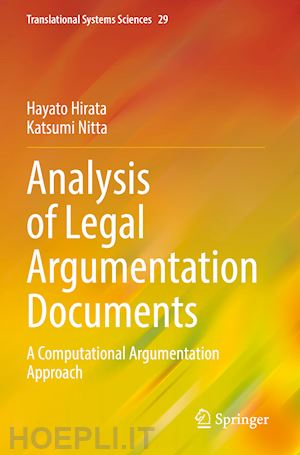
Questo prodotto usufruisce delle SPEDIZIONI GRATIS
selezionando l'opzione Corriere Veloce in fase di ordine.
Pagabile anche con Carta della cultura giovani e del merito, 18App Bonus Cultura e Carta del Docente
First, a method to automatically evaluate argumentation skills from the records of argumentation exercises is proposed. In law school, argumentation exercises are often conducted and many records of them are produced. From each utterance in the record, a pattern of “speech act +factor” is extracted, and argumentation skills are evaluated from the sequences of the patterns, using a scoring prediction model constructed by multiple regression analyses between the appearance pattern and the scoring results. The usefulness of this method is shown by applying it to the example case “the garbage house problem”.
Second, a method of extracting factors (elements that characterize precedents and cases) and legal topoi from individual precedents and using them as the expression of precedents to analyze how the pattern of factors and legal topoi appearing in a group of precedents affects the judgment (plaintiff wins/defendant wins) is proposed. This method has been applied to a group of tax cases.
Third, the logical structure of 70 labor cases is described in detail by using factors and a bipolar argumentation framework (BAF) and an (extended argumentation framework (EAF) together. BAF describes the logical structure between plaintiff and defendant, and EAF describes the decision of the judge. Incorporating the legal topoi into the EAF of computational argumentation theory, the strength of the analysis of precedents by combined use of factored BAF and EAF, not only which argument the judge adopted could be specified. It was also possible to determine what kind of value judgment was made and to verify the logic. The analysis methods in this book demonstrate the application of logic-based AI methods to the legal domain, and they contribute to the education and training of law school students in logical ways of argumentation.Chapter 1. Introduction .- Chapter 2. Related Research.- Chapter 3.- Factor-Based Argumentation Evaluation.- Chapter 4. Case Analysis Using Factors and Legal Topoi.- Chapter 5. Case Analysis for Case Law Education using Factors and Computational Argumentation Theory.- Chapter 6. Conclusion.
Prof. Hayato Hirata, Professor at Asahi University (Faculty of Law and Graduate School of Law), received BA from Chuo University (1980), MA from Hiroshima University (1983, Master of Laws), Dr. of Laws from Meiji Gakuin University (2016, by thesis only), and Dr. of Engineering from Tokyo Institute of Technology Graduate School (2021). He had been the Dean of Asahi University School of Law (2013–2017) and Library Director of Asahi University (2019–2021). He is the President of the Japan Association of Business Management Law (2020–present). He has received the Award of the President of Nagoya District Court (2010, as a Civil Commissioner) and 2022 Award of the President of the Aichi Prefecture Civil Mediation Federation (2022, as a Civil Conciliation). He holds doctorates in two different fields, laws and engineering, and his research is an integration of arts and sciences.











Il sito utilizza cookie ed altri strumenti di tracciamento che raccolgono informazioni dal dispositivo dell’utente. Oltre ai cookie tecnici ed analitici aggregati, strettamente necessari per il funzionamento di questo sito web, previo consenso dell’utente possono essere installati cookie di profilazione e marketing e cookie dei social media. Cliccando su “Accetto tutti i cookie” saranno attivate tutte le categorie di cookie. Per accettare solo deterninate categorie di cookie, cliccare invece su “Impostazioni cookie”. Chiudendo il banner o continuando a navigare saranno installati solo cookie tecnici. Per maggiori dettagli, consultare la Cookie Policy.